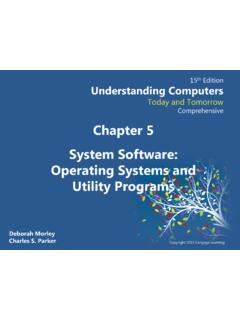Transcription of CS314 – Operating Systems - Stonehill College
1 Assignment Two CS314 Operating Systems This project was adapted from Gary Nutt's Excellent Book Kernel Projects for Linux published by Addison-Wesley 2001. You will learn how to write a unix shell program. This will give you the opportunity to learn how child processes are created to perform large-grained work and how the parent process can follow up on a child process's work. INTRODUCTION. A shell, or command line interpreter program, is a mechanism with which each interactive user can send commands to the OS and by which the OS can respond to the user. Whenever a user has successfully logged in to the computer, the OS causes the user process assigned to the login port to execute a specific shell. The OS does not ordinarily have a built-in window interface. Instead, it assumes a simple character-- oriented interface in which the user types a string of characters (terminated by pressing the Enter or Return key) and the OS responds by typing lines of characters back to the screen.
2 If the human-computer interface is to be a graphical windows interface, then the software that implements the window manager subsumes the shell tasks that are the focus of this exercise. Thus the character-oriented shell assumes a screen display with a fixed number of lines (usually 25) and a fixed number of characters (usually 80) per line. Once the shell has initialized its data structures and is ready to start work, it clears the 25-line display and prints a prompt in the first few character positions on the first line. Linux Systems are usually configured to include the machine name as part of the prompt. For example, my Linux machine is named , so the shell prints, as its prompt string: kiowa>. or bash>. depending on which shell I am using. The shell then waits for the user to type a command line in response to the prompt. The command line could be a string such as: kiowa> ls al terminated with an <ENTER> or return character (in Linux, this character is represented internally by the NEWLINE character, '\n').
3 When the user enters a command line, the shell's job is to cause the OS to execute the command embedded in the command line. Every shell has its own language syntax and semantics. In the standard Linux shell, bash, a command line has the form: command [arg1] [arg2] .. [argN]. in which the first word is the command to be executed and the remaining words are arguments expected by that command. The number of arguments depends on which command is being executed. For example, the directory listing command may have no arguments-simply by the user's typing ls or it may have arguments prefaced by the negative - character, as in ls al , where a and l are arguments. The command determines the syntax for the arguments, such as which of the arguments may be grouped (as for the a and l in the ls command), which arguments must be preceded by a "-" character, and whether the position of the argument is important. Other commands use a different argument-passing syntax. For example, a g++ compiler command might look like: kiowa> g++ -g -o deviation -S lmath in which the arguments g, o deviation, S, , , and lmath are all passed to the C++ compiler, g++.
4 The shell relies on an important convention to accomplish its task: The command for the command line is usually the name of a file that contains an executable program, for example, ls and g++ (files stored in /bin on most unix -style machines). In a few cases, the command is not a filename but rather a command that is implemented within the shell. For example, cd (change directory) is usually implemented within the shell itself rather than in a file in /bin. Because the vast majority of the commands are implemented in files, you can think of the command as actually being a filename in some directory on the machine. This means that the shell's job is to: 1 - find the file 2 - prepare the list of parameters for the command, 3 - cause the command to be executed using the parameters. Many shell programs are used with unix variants, including the original Bourne shell (sh), the C shell (csh) with its additional features over sh, the Korn shell, and the standard Linux shell (bash).
5 All have followed a similar set of rules for command line syntax, though each has a superset of features. Basic unix -Style Shell Operation The Bourne shell is described in Ritchie and Thompson's original unix paper [Ritchie and Thompson, 1974]. As described in the previous subsection, the shell should accept a command line from the user, parse the command line, and then invoke the OS to run the specified command with the specified argu- ments. This command line is a request to execute the program in any file that contains a program, including programs that the user wrote. Thus a programmer can write an ordinary C program, compile it, and have the shell execute it just like it was a unix command. For example, suppose that you write a C++ program in a file named and then compile and execute it with shell commands such as: kiowa> g++ -c I. o kiowa> g++ -o main kiowa> ./main For the first command line, the shell will find the g++ command (the C++ compiler) in the /bin directory and then, when the g++ command is executed, pass it the string The C++ compiler will translate the C++ program that is stored in and write the resulting object file named in the current directory.
6 The next command links the object file into an executable. The third command is simply the name of the file to be executed, main, without any parameters. The shell finds the main file in the current directory and then executes it. Consider the following steps that a shell must take to accomplish its job. 1. Print a prompt. A default prompt string is available, sometimes hardcoded into the shell, for example the single character string %, #, or >. When the shell is started, it can look up the name of the machine on which it is running and prepend this string to the standard prompt character, for example a prompt string such as kiowa>. The shell also can be designed to print the current directory as part of the prompt, meaning that each time that the user types cd to change to a different directory, the prompt string is redefined. Once the prompt string is determined, the shell prints it to stdout whenever it is ready to accept a command line. 2. Get the command line.
7 To get a command line, the shell performs a blocking keyboard input operation so that the process that executes the shell will be asleep until the user types a command line in response to the prompt. Once the user types the command line (and terminates it with a NEWLINE ('\n') character), the command line string is returned to the shell. 3. Parse the command. The syntax for the command line is trivial. The parser begins at the left side of the command line and scans until it sees a whitespace character (such as space, tab, or NEWLINE). The first word is the command name, and subsequent words are the parameters. 4. Find the file. The shell provides a set of environment variables for each user. These variables are first defined in the user's Iogin file (for the bash shell this is /home/<username>/.bashrc) but they can be modified at any time by using the set command. The PATH environment variable (whose value can be viewed by typing echo $PATH at the bash shell) is an ordered list of absolute pathnames specifying where the shell should search for command files.
8 If the Iogin file has a line such as: set path=(.:/bin:/usr/bin). then the shell will first look in the current directory (since the first full pathname is ":."), then in /bin, and finally in /usr/bin. If no file with the same name as the command can be found in any of the specified directories, then the shell notifies the user that it is unable to find the command. 5. Prepare the parameters. The shell simply passes the parameters to the command as the argv array of pointers to strings. 6. Execute the command. The shell must execute the executable program in the specified file. unix shells have always been designed to protect the original process from crashing when it executes a program. That is, since a command can be any executable file, then the process that is executing the shell must protect itself in case the executable file contains a fatal error. Somehow, the shell wants to launch the executable so that even if the executable contains a fatal error (which destroys the process executing it), then the shell will remain unharmed.
9 The Bourne shell uses multiple processes to accomplish this by using the unix -style system calls fork(), execvp(), and wait(). fork(). The fork() system call creates a new process that is a copy of the calling process, except that it has its own copy of the memory, its own process ID (with the correct relationships to other processes), and its own pointers to shared kernel entities such as file descriptors. After fork() has been called, two processes will execute the next statement after the fork() in their own address spaces: the parent and the child. If the call succeeds, then in the parent process fork() returns the process ID of the newly created child process and in the child process, fork() returns a zero value. execvp(). The execvp() system call changes the program that a process is currently executing. It has the form: execvp(char* path, char* argv[]);. The path argument is the pathname of a file that contains the new program to be executed. The argv[] array is a list of parameter strings.
10 When a process encounters the execvp() system call, the next instruction it executes will be the one at the entry point of the new executable file. Thus the kernel performs a considerable amount of work in this system call. It must: - find the new executable file, - load the file into the address space currently being used by the calling process (overwriting and discarding the previous program), - set the argv array and environment variables for the new program execution, and start the process executing at the new program's entry point. Various versions of execvp() are available at the system call interface, differing in the way that parameters are specified (for example, some use a full pathname for the executable file and others do not). wait(). The wait() system call is used by a process to block itself until the kernel signals the process to execute again, for example because one of its child processes has terminated. When the wait() call returns as a result of a child process's terminating, the status of the terminated child is returned as a parameter to the calling process.


